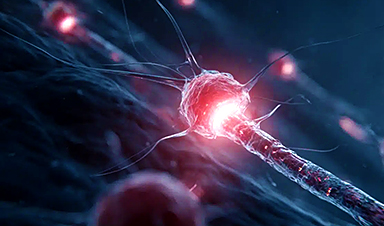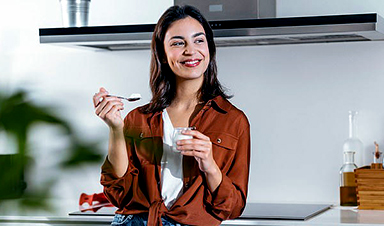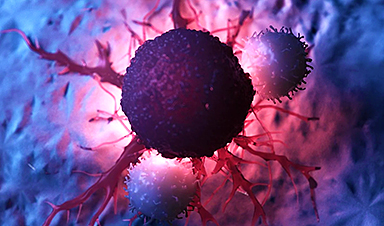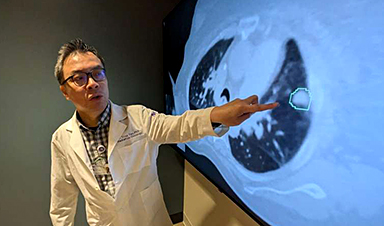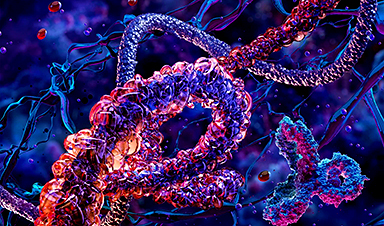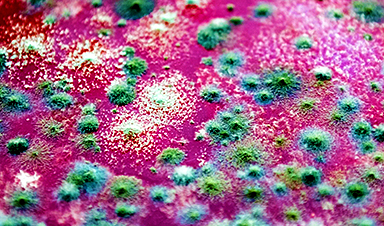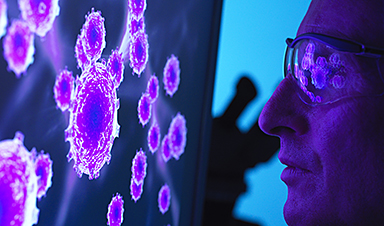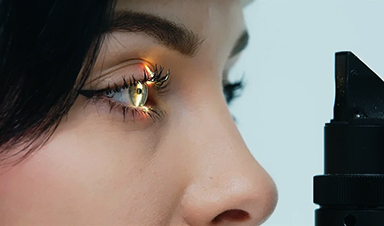Cedars-Sinai Cancer investigators have developed a new nanotechnology-based test that can detect and profile prostate cancers—even in microscopic amounts. Their work, published in the journal Nano Today, suggests that this “liquid biopsy” test could spare many patients unnecessary treatment-related side effects, directing them instead to effective therapies that could prolong their lives.
Cancer of the prostate, a walnut-sized gland just below the bladder, is the most common cancer and second-leading cause of cancer death among U.S. men.
The test developed by Posadas and co-investigators isolates and characterizes extracellular vesicles, also called EVs, from blood samples. EVs are microscopic packets of protein and genetic material that are shed by cells. The EV Digital Scoring Assay can pull these EV packets from the blood with unprecedented efficiency and analyze them in a manner that is faster than any currently available test.
The investigators tested blood samples from 40 patients with prostate cancer and found that the test was able to distinguish cancer localized to the prostate from cancer that had spread to other parts of the body.
Posadas envisions this test being used to help patients who have their prostate gland removed and later experience a rise in levels of prostate-specific antigen (PSA) in their blood. This happens in about 30% of post-surgical patients, and elevated PSA levels can indicate cancer recurrence.
If a remnant of the cancer has been left behind in the prostate bed, where the prostate gland once was, Posadas said focused radiation therapy can cure the disease or delay progression. But that treatment is not without risks.
“The bladder and rectum are near the prostate bed and can be damaged during the course of radiation therapy,” Posadas said. “The risk is only worth it if a man is going to benefit.”
If microscopic cancer deposits have spread outside the prostate area, focused radiation treatment will not prevent disease progression. These deposits, called micro-metastases, are not always detectable, even via the most advanced imaging, but investigators were able to detect them using the EV test.
“This would allow many patients to avoid the potential harms of radiation that isn’t targeting their disease, and instead receive systemic therapy that could slow disease progression,” Posadas said.
In retrospective case studies, investigators tested blood samples taken over time from three prostate cancer patients, including one patient who had undergone focused radiation treatments.
“At the time he was being treated, I was concerned that he was not benefiting,” Posadas said. “And the test results mirrored his clinical behavior and showed that, indeed, the treatments were not effective because he had micro-metastatic disease.”
The test is the latest in a yearslong series of Cedars-Sinai Cancer breakthroughs involving EVs. Posadas said that it could also be adapted to guide treatment as prostate cancer therapies become more targeted at the molecular level, ultimately extending patients’ lives. Posadas and his team of investigators are now working to further refine the test so that it can be studied in greater detail.
“This type of liquid biopsy, coupled with innovations such as our Molecular Twin initiative, is key to next-generation precision medicine that represents the newest frontier in cancer treatment,” said Dan Theodorescu, MD, Ph.D., director of Cedars-Sinai Cancer and the PHASE ONE Distinguished Chair.
“And the type of progress we are making is only possible at an institution such as Cedars-Sinai Cancer, where we have patients, clinicians, scientists and creative engineering minds converging as one unit to address the most challenging problems in cancer.”
Posadas and the team aim to work with local and national partners and hope to see the test come into wide clinical practice in the near future.
News
Team finds flawed data in recent study relevant to coronavirus antiviral development
The COVID pandemic illustrated how urgently we need antiviral medications capable of treating coronavirus infections. To aid this effort, researchers quickly homed in on part of SARS-CoV-2's molecular structure known as the NiRAN domain—an [...]
Drug-Coated Neural Implants Reduce Immune Rejection
Summary: A new study shows that coating neural prosthetic implants with the anti-inflammatory drug dexamethasone helps reduce the body’s immune response and scar tissue formation. This strategy enhances the long-term performance and stability of electrodes [...]
Scientists discover cancer-fighting bacteria that ‘soak up’ forever chemicals in the body
A family of healthy bacteria may help 'soak up' toxic forever chemicals in the body, warding off their cancerous effects. Forever chemicals, also known as PFAS (per- and polyfluoroalkyl substances), are toxic chemicals that [...]
Johns Hopkins Researchers Uncover a New Way To Kill Cancer Cells
A new study reveals that blocking ribosomal RNA production rewires cancer cell behavior and could help treat genetically unstable tumors. Researchers at the Johns Hopkins Kimmel Cancer Center and the Department of Radiation Oncology and Molecular [...]
AI matches doctors in mapping lung tumors for radiation therapy
In radiation therapy, precision can save lives. Oncologists must carefully map the size and location of a tumor before delivering high-dose radiation to destroy cancer cells while sparing healthy tissue. But this process, called [...]
Scientists Finally “See” Key Protein That Controls Inflammation
Researchers used advanced microscopy to uncover important protein structures. For the first time, two important protein structures in the human body are being visualized, thanks in part to cutting-edge technology at the University of [...]
AI tool detects 9 types of dementia from a single brain scan
Mayo Clinic researchers have developed a new artificial intelligence (AI) tool that helps clinicians identify brain activity patterns linked to nine types of dementia, including Alzheimer's disease, using a single, widely available scan—a transformative [...]
Is plastic packaging putting more than just food on your plate?
New research reveals that common food packaging and utensils can shed microscopic plastics into our food, prompting urgent calls for stricter testing and updated regulations to protect public health. Beyond microplastics: The analysis intentionally [...]
Aging Spreads Through the Bloodstream
Summary: New research reveals that aging isn’t just a local cellular process—it can spread throughout the body via the bloodstream. A redox-sensitive protein called ReHMGB1, secreted by senescent cells, was found to trigger aging features [...]
AI and nanomedicine find rare biomarkers for prostrate cancer and atherosclerosis
Imagine a stadium packed with 75,000 fans, all wearing green and white jerseys—except one person in a solid green shirt. Finding that person would be tough. That's how hard it is for scientists to [...]
Are Pesticides Breeding the Next Pandemic? Experts Warn of Fungal Superbugs
Fungicides used in agriculture have been linked to an increase in resistance to antifungal drugs in both humans and animals. Fungal infections are on the rise, and two UC Davis infectious disease experts, Dr. George Thompson [...]
Scientists Crack the 500-Million-Year-Old Code That Controls Your Immune System
A collaborative team from Penn Medicine and Penn Engineering has uncovered the mathematical principles behind a 500-million-year-old protein network that determines whether foreign materials are recognized as friend or foe. How does your body [...]
Team discovers how tiny parts of cells stay organized, new insights for blocking cancer growth
A team of international researchers led by scientists at City of Hope provides the most thorough account yet of an elusive target for cancer treatment. Published in Science Advances, the study suggests a complex signaling [...]
Nanomaterials in Ophthalmology: A Review
Eye diseases are becoming more common. In 2020, over 250 million people had mild vision problems, and 295 million experienced moderate to severe ocular conditions. In response, researchers are turning to nanotechnology and nanomaterials—tools that are transforming [...]
Natural Plant Extract Removes up to 90% of Microplastics From Water
Researchers found that natural polymers derived from okra and fenugreek are highly effective at removing microplastics from water. The same sticky substances that make okra slimy and give fenugreek its gel-like texture could help [...]
Instant coffee may damage your eyes, genetic study finds
A new genetic study shows that just one extra cup of instant coffee a day could significantly increase your risk of developing dry AMD, shedding fresh light on how our daily beverage choices may [...]


